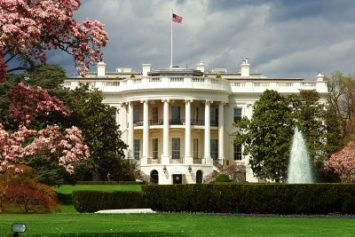The responsibilities of the White House Council on Environmental Quality (CEQ) are clearly spelled out in the 1969 National Environmental Policy Act (NEPA). But the gap between Republicans and Democrats over how the CEQ should implement those responsibilities is so wide that an objective observer might conclude that the two parties are not talking about the same agency or the same law.
One stark difference—and, arguably, the most consequential one—was readily apparent at a May 15, 2019, hearing of the Senate Committee on Environment and Public Works (EPW). The title of the hearing was Oversight of the Council on Environmental Quality (transcript here), and the only witness was Mary Neumayr, the CEQ chair nominated by President Donald Trump and approved by the Senate in January 2019. In her opening four-page statement, Neumayr mentioned greenhouses gases (GHGs) only once, in relation to a Trump Executive Order (EO) directing the CEQ to rescind guidance the CEQ wrote during the Obama administration on how GHGs and climate change should be considered in NEPA environmental reviews. The CEQ is currently drafting a new GHG guidance document. However, Neumayr’s written statement at the EPW hearing does not include the word climate or any acknowledgment that the CEQ is currently drafting measures to ensure that federal agencies will factor GHGs into their decision-making as a way to mitigate climate change.
In contrast, comments by the three Democratic senators who spoke at the hearing focused on climate change and what, if anything, the CEQ is doing to address the issue. Neumayr said she was aware of the concerns about climate change raised by many scientists, financial institutions, and government agencies (including U.S. agencies) and also believed that the climate is changing in part because of human activity. But, as is true for other officials in the current administration, she would not take a position on the extent of human influence.
NEPA Process Needs a Fix
What Neumayr did focus on in her statement and responses to questions, and an issue also emphasized by Republicans on the committee, was the ongoing work by the CEQ and other federal agencies to expedite the federal permitting process for major infrastructure projects. Under NEPA, federal agencies must assess the environmental effects of proposed actions before any agency may issue permits authorizing those actions. The CEQ plays a central role in this process by ensuring that the agencies meet their obligations under NEPA. Mainly, the CEQ issues guidance and interprets regulations that implement NEPA’s procedural requirements. The CEQ also reviews and approves federal agency NEPA procedures, approves alternative arrangements for compliance with NEPA for emergencies, and helps to resolve disputes between federal agencies and with other governmental entities, including the states, and members of the public.
The long-standing complaint raised by Republicans who spoke at the hearing is that the NEPA process, particularly with regard to closing out major federal reviews of proposed actions (called Environmental Impact Statements (EISs)), is unnecessarily long. Absent a completed EIS, federal permits may not be issued. There are various estimates of the amount of time it takes to complete an EIS. In the hearing, Senator John Barrasso (R-WY) cited a December 2018 CEQ report that found that it took an average of 41/2 years to complete an EIS. But for some projects, the wait can be much longer, a point made by Senator Dan Sullivan (R-AK).
“Keystone Pipeline, that took eight years and counting to permit,” said Sullivan. “As you know, there are projects, really important projects—the Gross Reservoir in Colorado, 14 years to permit that; the Kensington Gold Mine in Alaska, almost 20 years to permit that. On average, it takes 9 to 19 years to permit a federal highway.”
Hence the major focus of Republicans at the hearing was obtaining assurances from Neumayr that the federal government was on track to meet its goal of completing environmental reviews in 2 years or less. Neumayr seemed to provide those assurances.
“We have been working to ensure that agencies put in place schedules, that they have processes in place to elevate issues that might result in delays in the schedules, and that they work towards meeting the two-year goal,” testified Neumayr. “In addition, we have been working with the agencies on looking at their own policies and procedures to help reduce delay.”
CEQ Under Obama
Everything said in the hearing is a reflection of and, at least with Neumayr, a part of presidential policy. In terms of climate change, the current administration and the CEQ seem to be drifting far afield from the direction the CEQ took under President Barack Obama. That direction was explained in a lengthy August 2016 CEQ guidance memo (Final Guidance for Federal Departments and Agencies on Consideration of Greenhouse Gas Emissions and the Effects of Climate Change in National Environmental Policy Act Reviews).
“Climate change is a fundamental environmental issue, and its effects fall squarely within NEPA’s purview,” the memo stated. “CEQ is issuing the guidance to provide for greater clarity and more consistency in how agencies address climate change in the environmental impact assessment process. This guidance uses long[-]standing NEPA principles because such an analysis should be similar to the analysis of other environmental impacts under NEPA.”
The guidance lists recommendations about quantifying GHG impacts in agency environmental reviews and also directs agencies to include discussions of key GHG/climate change issues. For example, the guidance:
- Recommends that agencies quantify a proposed action’s projected direct and indirect GHG emissions;
- Discusses methods to appropriately analyze reasonably foreseeable direct, indirect, and cumulative GHG emissions and climate effects;
- Guides the consideration of reasonable alternatives and recommends that agencies consider the short- and long-term effects and benefits in their alternatives and mitigation analyses;
- Advises agencies to use available information when assessing the potential future state of the affected environment in a NEPA analysis, instead of undertaking new research;
- Counsels agencies to use the information developed during the NEPA review to consider alternatives that would make the actions and affected communities more resilient to the effects of a changing climate;
- Recommends that agencies select the appropriate level of NEPA review to assess the broad-scale effects of GHG emissions and climate change. (EISs are comprehensive environmental reviews; Environmental Assessments are a less comprehensive type of review performed to determine if an EIS is needed or if a Finding of No Significant Impact (FONSI) can be made; a Categorical Exclusion applies to actions that do not individually or cumulatively have an environmental impact.); and
- Counsels agencies that the rule of reason inherent in NEPA and the CEQ regulations allows agencies to determine, based on their expertise and experience, how to consider an environmental effect and prepare an analysis based on the available information.
“Focused and effective consideration of climate change in NEPA reviews will allow agencies to improve the quality of their decisions,” the guidance states. “Identifying important interactions between a changing climate and the environmental impacts from a proposed action can help [f]ederal agencies and other decision[-]makers identify practicable opportunities to reduce GHG emissions, improve environmental outcomes, and contribute to safeguarding communities and their infrastructure against the effects of extreme weather events and other climate-related impacts.”

Trump’s EOs
Upon taking office, Trump has taken several steps to begin shrinking federal involvement in climate change issues, including informing the CEQ that shortening environmental reviews must be its top priority.
First, in March 2017, the president issued EO 13783 (Promoting Energy Independence and Economic Growth), which, among other things, revoked the CEQ’s August 2016 GHG/climate change guidance document.
Next, in August 2017, the president issued EO 13807 (Establishing Discipline and Accountability in the Environmental Review and Permitting Process for Infrastructure Projects). The EO directed all federal agencies to “conduct environmental reviews and authorization processes in a coordinated, consistent, predictable, and timely manner in order to give public and private investors the confidence necessary to make funding decisions for new infrastructure projects; speak with a coordinated voice when conducting environmental reviews and making authorization decisions; and make timely decisions with the goal of completing all federal environmental reviews and authorization decisions for major infrastructure projects within 2 years.”
EO 13807 also instructed the CEQ to undertake actions it deems necessary to modernize and enhance the environmental review and authorization process, including through issuance of regulations and guidance. Subsequently, the CEQ and the White House Office of Management and Budget (OMB) issued guidance to federal agencies on carrying out one major objective of EO 13807—processing environmental reviews and authorization decisions for major infrastructure projects as one federal decision—that is, ending the practice of multiple federal agencies pursuing separate paths to complying with NEPA. The federal agencies followed shortly thereafter with a collective memorandum of understanding establishing “a cooperative relationship for the timely processing of environmental reviews and authorization decisions for proposed major infrastructure projects under the One Federal Decision (OFD) policy established in EO 13807.” The specific purposes of the MOU are to:
- Provide a more predictable, transparent, and timely federal review and authorization process for delivering major infrastructure projects.
- Establish standard operating procedures for how the federal government will make concurrent and synchronized reviews for major infrastructure projects.
- Eliminate duplication of effort among agencies; improve the efficiency of project delivery; make better-informed decisions; and promote good environmental, community, and economic outcomes.
CEQ Solicits Public Comment
Also, in June 2018, the CEQ issued an advanced notice of proposed rulemaking (ANPR), soliciting public comment on potential changes to its regulations. The CEQ specifically requested feedback on 20 “potential revisions to … ensure a more efficient, timely, and effective NEPA process.” According to Neumayr, the CEQ is currenting considering over 12,500 responses to the ANPR it received. Specific questions for which the CEQ requested feedback included the following:
- Should the CEQ’s NEPA regulations be revised to ensure that environmental reviews and authorization decisions involving multiple agencies are conducted in a manner that is concurrent, synchronized, timely, and efficient, and if so, how?
- Should the CEQ’s NEPA regulations be revised to make the NEPA process more efficient by better facilitating agency use of environmental studies, analysis, and decisions conducted in earlier federal, state, tribal, or local environmental reviews or authorization decisions, and if so, how?
- Should the CEQ’s NEPA regulations be revised to provide greater clarity to ensure NEPA documents better focus on significant issues that are relevant and useful to decision-makers and the public, and if so, how?
- Should the CEQ’s NEPA regulations relating to public involvement be revised to be more inclusive and efficient, and if so, how?
- Should the CEQ’s regulations relating to the timing of agency action be revised, and if so, how?
- Should the CEQ’s regulations relating to agency responsibility and the preparation of NEPA documents by contractors and project applicants be revised, and if so, how?
- Should the CEQ’s NEPA regulations relating to the appropriate range of alternatives in NEPA reviews and which alternatives may be eliminated from detailed analysis be revised, and if so, how?
As with the other Trump administration documents noted above, the ANPR does not include the phrases greenhouse gases or climate change. Neumayr told the EPW that the CEQ has sent the OMB its draft guidance relating to consideration of GHG emissions when conducting NEPA analyses.

